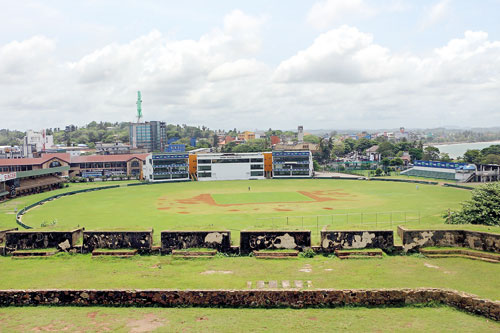Galle Stadium under the radar once again

The picturesque Galle International Cricket Stadium looks breathtaking from the Galle Fort
The Advisory Mission sent by International Council On Monuments and Sites (ICOMOS) has recommended that Sri Lanka Cricket (SLC) take the under mentioned action to preserve the Outstanding Value of the World Heritage site of the Old Town of Galle and its fortifications and while keeping the Galle International Cricket Stadium functional.
It is understood that Sri Lanka Cricket has called upon its architects to make the required alterations as recommended by the advisory panel.
Additional Director General of Archaeology Prasanna Rathnayake told the Sunday Times last Thursday that the Departments primary concern was to safeguard the eight world heritage listed sites in Sri Lanka which includes the old town of Galle and its fortifications. And the department would not want any of the eight to be struck off the UNESCO list of heritage sites. The ancient cities of Polonnaruwa and Sigiriya, the sacred cities of Anuradhapura and Kandy, the Golden Temple of Dambulla, the Central highlands of Sri Lanka and the old town of Galle and its fortifications are the eight heritage sites in Sri Lanka listed by UNESCO.  “We can’t afford to be delisted as we cannot dream of spending even a portion of what other nations spend to promote their applications for listing as a World Heritage site. Our approval is required to carry out any construction or renovation within a heritage site. From time to time UNESCO has requested us to take action to remove unapproved constructions which have been built within the old Galle Fort and its buffer zone if Galle is to safeguard its heritage listing. It is our duty to take necessary action to safeguard the old Galle fort as a UNESCO heritage site and we are bound to do so in the interest of the nation and our future generations”.
The letter sent to SLC also states that the Ministry of Education together with the Department of Archeology, Galle Heritage Foundation, Tourism Development Authority, Urban Development Authority (UDA) and the Galle Municipal Council are in the process of addressing the other issues highlighted in the final advisory report.
“The picturesque Galle International Cricket ground” as many an international commentator refers to is said to have been built as a race course way back in 1876. It was officially recognised as a cricket ground in 1927 and the first turf wicket is said to have been laid in1945. The first test match to be played at the Galle stadium was between Sri Lanka and New Zealand in June 1998. The ground was devastated by the Indian Ocean Tsunami in December 2004 after which it was rebuilt by relocating the Club House of Galle Cricket Club and the Galle Municipal Council pavilion and the fully air conditioned Mahinda Rajapaksa Pavilion being built where the Galle CC club house and Municipal pavilion stood. The ground and new buildings were opened by former President Mahinda Rajapaksa himself on 17th December 2017. Galle has been a lucky venue for our national team as of the 29 test matches played at the Galle International Cricket ground Sri Lanka has won 17, lost 6 and drawn 6 games.
As recorded in the UNESCO web of the 1052 properties listed by UNESCO as world heritage sites 55 have been named as being in danger of being delisted and the old Galle town and its fortifications are not among this 55. The last site to be delisted was Germany’s Dresden Elbe Valley which was struck off the list in 2009 while the Arabian Orynx Sactuary was struck off in 2007 which proves how much a nation values its UNESCO heritage listing.
| Recommendation No 13 of the 16 recommendations made by the ICOMOS advisory panel that visited the heritage site recommends that Sri Lanka Cricket (SLC) 1. Commit to a process and time frame for the demolition of the semi-derelict indoor nets building 2. Remove the other temporary structures on the edge of the pitch area (Temporary changing rooms and a shipping container) immediately. 3. Deploy temporary fencing and stands when big matches are played and tickets must be sold so that further visual impacts on the World Heritage Property are avoided. 4. Consider potential floodlighting in close consultation with all interested parties on the basis that if permission is granted it should be temporary and that only retractable flood lights would be acceptable 5. Acknowledge that while the present buildings will remain for the time being that there will be no further building and that when the time comes to alter or renew the present pavilions this will occur with the close consultation of the CWC and the World Heritage Committee and Advisory Bodies as required by the Operational Guidelines for the implementation of the World heritage Convention of July 2015 to ensure that any further buildings do not intrude on the entrance to the Old Galle town thereby affecting the Outstanding Universal Value of the property in the way that the present buildings do. | |


